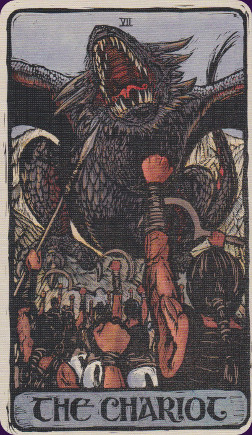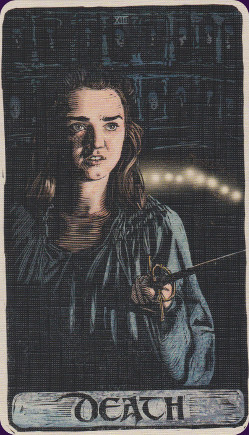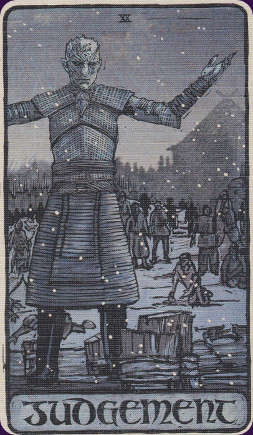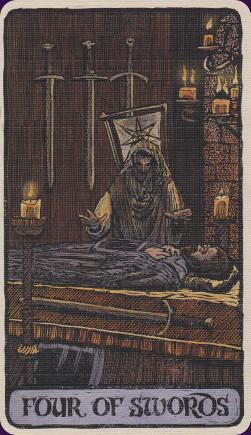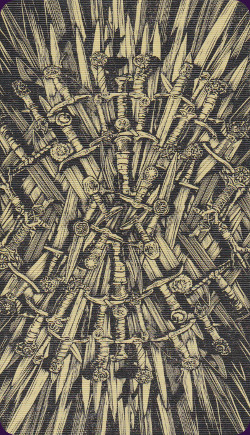Game of Thrones Tarot Deck Review

Creators: Liz Dean, Craig Coss
Published: 2018
The Game of Thrones Tarot takes inspiration from the first six seasons of the TV show, created from George R.R. Martin's book series, and merges them with the Rider-Waite-Smith tarot archetypes. Familiar characters and scenes have been merged into a functional as well decorative and fan-appreciated deck.
Retailers
See Price at Amazon.comSee Price at Amazon.co.uk
See Price at Amazon.ca
Game of Thrones Tarot Review by medusawink
Game of Thrones is a televisual spectacular based on the enormously successful series of novels, A Song of Ice and Fire, by George RR Martin. With the seventh and penultimate series having screened in 2017, and more than a year's wait until the final season, fans are filling in their time musing on the meanings of convoluted subplots and speculating on what the 'bittersweet ending’ promised by Martin himself, will involve. More than one tarot aficionado has attempted to divine the ending of the series, and their predictions can be found on You Tube, and through Google searches.
Into this world of rabid fandom comes the official Game of Thrones Tarot, a brave gambit if ever there was one. The television series has provided viewers with so many iconic scenes, and so much potential for use in illustrating a tarot deck that as satisfying as this one is, not everyone is going to be happy with it.
— 2019 UPDATE —
Ah, such was my optimism and naďveté when I originally wrote this. But then again no one could have presaged what was to come. Be warned – what follows is full of plot spoilers and rabid opinion, so if you have not yet viewed Game of Thrones season 8 you may wish to stop reading about now. Or, you could do yourself a big favour and simply not watch it at all.
Game of Thrones is now in/famously finished, and to say that its final season was divisive is a massive understatement. To the bitter disappointment and shock of many fans story arcs were discarded, subplots tossed aside, continuity and logic evaporated, character development ignored or worse obliterated, and the subtle development of story abandoned in favour of CGI spectacle.
The Game of Thrones Tarot was created predicated on storylines established largely in the first five seasons of the television show – where characters were clearly delineated and supported with appropriate cinematic storytelling devices. The GOT Tarot casts characters as they were presented to the audience, with Daenerys Targaryen and Jon Snow as the heroic central characters, Cersei and Tyrion as somewhat morally ambivalent, and the Night King as the ultimate villain. My, my how things change.
While it was always a given that not every character was going to survive to the end of the series it is hard to reconcile many of the TV show characters with the roles in which they have been cast in the GOT Tarot.
The worst, unsurprisingly, is Daenerys who in a massive volte face went from saviour to deranged pyromaniac, and is now scarcely the ideal figure to depict The Empress, nor is the ineffectual and treacherous Jon Snow an ideal Emperor. The Night King, presented to the viewer as the ultimate evil, turned out to be nothing more than a badly behaved tourist who was dispatched by a teenager with a magic cheese knife. He barely deserves the kudos he receives as Judgement, the King of Swords, and all round generally menacing presence. Cersei is terribly miscast as the Queen of Swords, better she was the Queen of Cups given that she was regularly in them. Arya Stark still stands up well as Death, especially since she knows a killer when she sees one. Bran Stark who turned out to be a merciless conniver is not exactly great Hermit or Page of Cups material either. It is not my intention to list all the images which have become problematic, since there are way too many. However, this does not render the deck useless or out of date, in fact it has become a touching Time Capsule which carries the tarot reader back to happier times - Arya had just arrived in Braavos, Jon was still up North in the snow, and Dany in Essos dealing with Harpies and teenage dragons. One could almost become nostalgic for the good old days when Game of Thrones held out the promise of a complex story well told.
— END OF 2019 UPDATE —
The deck jumps straight into the heart of Game of Thrones with The Fool depicted by Tyrion freeing one of the dragons (my money is on Viserion) from his dungeon under the great Pyramid of Meereen. From here we see many of the high-powered players from GOT embodying the essences of the Major Arcana. Littlefinger is cast as The Magician, Melissandre is the High Priestess, the Mother of Dragons herself is the Empress (although many could argue that Caitlin Stark would be better cast in this role), Jon Snow is, unsurprisingly, the Emperor, and Varys is the Heirophant. Many of the most popular characters in Game of Thrones appear repeatedly throughout the deck… Here's the breakdown; Daenerys and Jon – 5 appearances, Bran, Arya, Littlefinger, Sansa, and the Dragons all put in 4 appearances with Drogon dominating The Chariot and The Sun. Brienne and Sam star in three cards, and Tyrion, Varys, Cersei, and Ned feature in 2 cards each. The Unsullied have quite a presence particularly in the suit of Spears however the Dothraki have no part in this deck. Others such as the Night King and Jaime Lannister only have minimal part to play despite their linchpin roles in the TV series.
The creators of the deck have picked over and chosen both major and minor scenes from the first six seasons of Game of Thrones and in doing so have missed out on some of the spectacle depicted in season seven – Daenerys’ and Drogon’s attack on the loot train being one tarot-worthy scene that springs immediately to mind. While many iconic scenes have been shown in this deck just as many have been skipped over… We can all puzzle over the absence of Sansa’s devastating little smirk as her evil soon-to-be-ex-husband, Ramsay Bolton, is devoured by his starving dogs, why Khal Drogo doesn't get a look in, or why The Battle of the Bastards and The Battle of Meereen are even partially depicted.
On the other hand we do get many glorious 'little moments’ that are otherwise often overlooked such as Arya’s awesome sneer of contempt as she picks up Needle to defend herself, Cersei mourning the death of her sons, Sansa and Jon enjoying a moment together as brother and sister reunited, Arya’s inauspicious arrival in Braavos, the Unsullied in action, and the marvellous Lady Olenna Tyrell in a moment of quiet reflection. Make no mistake these cards do capture the body language and emotion so ably depicted on the screen.
This is a fully illustrated 78 card tarot, with 22 Major Arcana and 56 Minor Arcana. The Game of Thrones Tarot is based on the Rider Waite Smith classic deck both visually and in spirit. A vast number of the cards have adapted scenes from GOT which authentically replicate Pamela Coleman Smith's iconic illustrations.
There are no renamed or reimagined Major Arcana cards, and the Minor Arcana suits are named Swords, Spears (replacing Wands), Coins, and Cups. The Court cards are Page, Knight, Queen, and King. The Major Arcana cards feature both a number and title, while the Minor Arcana cards feature their number as part of their title, which is given at the base of each image. While the Major Arcana tends to focus on the central players in Game of Thrones, the Minor Arcana features an odd mix of leading and minor characters on the number, and Court cards.
The cards measure 70 x 120 mm, which makes them a fairly average sized tarot deck. A deck of cards this size is made to fit comfortably into most people’s hands and be relatively easy to handle. The card stock is very light and extremely flexible to the point of being flimsy, it is only The textured linen finish which gives them any sense of sturdiness. If this deck is used by somebody who is particularly heavy-handed it could result in damage to the cards – their lightness makes them susceptible to creasing and breaking. The deck has rounded corners which does go some way to offsetting their fragility and preventing the cards from becoming tattered, and peeling. Alongside the textured finish, the cards also have a slight gloss which makes them easy to shuffle, in fact, texturally speaking, these cards are quite pleasurable to handle.
The print quality is excellent. Each image is rendered with clean, crisp lines, and the subtle yet strong colours are beautifully reproduced. There are no misprints, no colour bleeds, no blurred lines, nor are the images murky and difficult to distinguish.
The artwork is attractive and the faux-woodcut style fits in well with the mediaeval theme of Game of Thrones. The artist’s palette follows the grim-dark colour scheme established by the TV series – wintry greys, iron blues, pale icy blue, desert tans and browns, forest greens, and highlighted with fiery reds and oranges. The colours are moderated, yet because of the strong black outlines they do come across as a little bit comic book, somewhat reminiscent of the Arcus Arcanum Tarot and the illustrations by famed comic book artist Alex Raymond.
Each image has a narrow black border which is surrounded in turn by a narrow white frame which reaches to the edge of the card. Each card’s title is given in a coloured lozenge at the base of the image in a mediaeval-type script. The print on the back of the card features the many swords which make up the Iron Throne, in a colour scheme of heavy black and pale yellow. The image is symmetrical, thus reversible.
The cards come packaged in a solid cardboard box with a fold back top. The cover features images from the GOT deck as well as Celtic knot work, mediaeval borders, and GOT house sigils in metallic copper foil. The covers give the title of the deck, a brief description as well as manufacturer's details, copyright, publishers details, and barcodes. The inside of the box has plain bronze cardboard decoration, which will oxidise if you touch it with sticky or sweaty fingers. The cards and guidebook are seated in parallel wells, and both have an orange satin ribbon trailing beneath them to assist with lifting them from the box. The packaging is relatively light, and thin enough that it can be slipped into a backpack or tote bag without becoming burdensome. The box itself is sturdy enough to provide decent protection for the cards and guidebook it contains, however its paper covering could easily sustain damage if it comes in contact with sharp objects. And given that it is still basically made of cardboard, if it is put under pressure it will crush or break.
The tiny, hardback guidebook measures only 70 x 1 20 mm, and is packed with 106 pages of information. It opens with the inevitable brief history of tarot, and explains how images from Game of Thrones have been utilised to create a unique deck. This is followed by a three-page chapter titled 'How to Use This Book and Deck’– which gives the reader the fundamentals of preparing for and conducting a layout including brief information on reading reversed cards, intuitive reading, and closing a reading.
Several Game of Thrones themed spreads have been included, each one being well thought out and applicable to a Seeker’s needs. The classic three-card spread, Past-Present-Future has been adapted to the concept of Dragonglass representing the past, Milk of the Poppy representing the present, and Valyrian Steel representing the future. ‘The Red Keep’ , one of the seats of power in Westeros is a four-card spread with The Throne Room divining powerful influences in the Seeker's life, The Tower of the Hand indicating what needs to be done, The Secret Tunnels showing a secret advantage, and The Outcome - which is fairly self-explanatory.
The ‘Old Gods of the North’ is a five-card layout to determine what past influences are affecting the Seeker’s present. The Old Gods tells the reader what they need to know about a past issue, The Weirwood describes what strengthens the Seeker, The Children of the Forest indicates what needs to be watched over or protected, The Heart Tree describes what one can do now, and One with the Sight is effectively the outcome.
Faith of the Seven utilises the old gods, Father, Smith, Warrior, Maiden, Mother, Crone, Stranger to divine justice, skills, strengths, virtues, love, hopes/fears, and the unknown respectively. ‘I Drink and I Know Things’ one of Tyrion Lannister’s most famous quotes is used for this lighthearted six-card layout which examines the Seeker’s indulgences, learning, flaws, trials, debts, and the future. ‘Spread of the Maesters’ is a hefty 10 card layout referring to the links on a Maester’s chain which are awarded for mastering various arenas of knowledge: Astronomy (the present situation), Construction (foundations), History (the past), Ravenry (communication), Economics (finances), Smithing (work), Healing (relationships), Warcraft (strategies), Magic (what is hidden), Astrology (the future).
Following this introductory information the bulk of the book is given over to the Major Arcana, with each card receiving two pages including a 30 x 50 mm black-and-white reproduction of the card. The information opens with ‘key meanings’ which are a handful of buzzwords describing the essence of the card. Beneath this is a description of the illustration and how it pertains to the card’s meaning, included here is a numerological designation and an analysis of what that means. Divinatory meanings for both upright and reversed cards are given, and the upright cards of the Major Arcana are given additional meanings which sometimes step outside commonly accepted interpretations.
The Minor Arcana is analysed by suit rather than number with each card being reproduced in black and white miniature (12 x 21 mm). The Minor cards are afforded much less page space than the Major cards. Beneath each small image is a concise description of the illustration. Each card is given ‘key meanings’ as well as upright and reversed interpretations. The Court cards include a small character outline but the bulk of the interpretive information applies to situations rather than people. Divinatory meetings for both the Major and Minor Arcana are fairly standard and fall well inside the boundaries of commonly accepted interpretations.
Overall this deck it is well thought out and conceptually sound, and it is functional rather than merely decorative. The illustrations are professionally executed and there can be no doubt as to who and what they are depicting. The packaging and presentation are consistent and very attractive. If like half the people on this planet, you are a fan of Game of Thrones, and also have a good taste to be a tarot aficionado, then this is the deck for you! Aside from the fact that there are no other officially sanctioned Game of Thrones tarot decks available, there is absolutely nothing wrong with this one.
Although it has many visual references to the original RWS tarot I would not recommend it as being suitable for beginners - the GOT content it is a bit distracting. However, if you are familiar with the tarot then you will not have a problem in coming to grips with this deck. If you collect tarot decks then The Game of Thrones Tarot is attractive and worth having simply for the artwork, and if you are a fan of all things GOT then this tarot is going to be a must have.
Far more than a guilty pleasure the Game of Thrones Tarot is a lot of fun and an authentic working deck as well. You know you want it, and it's worth it.
Complete Details of Game of Thrones Tarot
Creators: Liz Dean, Craig CossPublisher: Chronicle Books 2018
Deck Type: Tarot Deck
Cards: 78
Major Arcana: 22
Minor Arcana: 56
Deck Tradition: Rider-Waite-Smith
Minor Arcana Style: RWS-Based Scenes
Suits: Swords, Spears, Coins, Cups
Court Cards: Page, Knight, Queen, King
Card Size: 2.76 x 4.72 in. = 7.00cm x 12.00cm
Card Language: English
Card Back: Reversible
Back Design: Illustrated close-up of the swords that make up the Iron Throne
Companion Material: 106-page hardback companion book is packaged with the deck.
Rating: 18/20 or
Similar Decks to Game of Thrones Tarot
Theme: Books & Literature, Fantasy, TV & MoviesCategory: Available Tarot Decks
Creator: Art of Tarot, Colour Your Tarot, Golden Tarot, Victorian Steampunk Tarot by Liz Dean
< Previous Deck · Back to Top · Next Deck >
Home > Tarot Reviews > Game of Thrones Tarot Review

